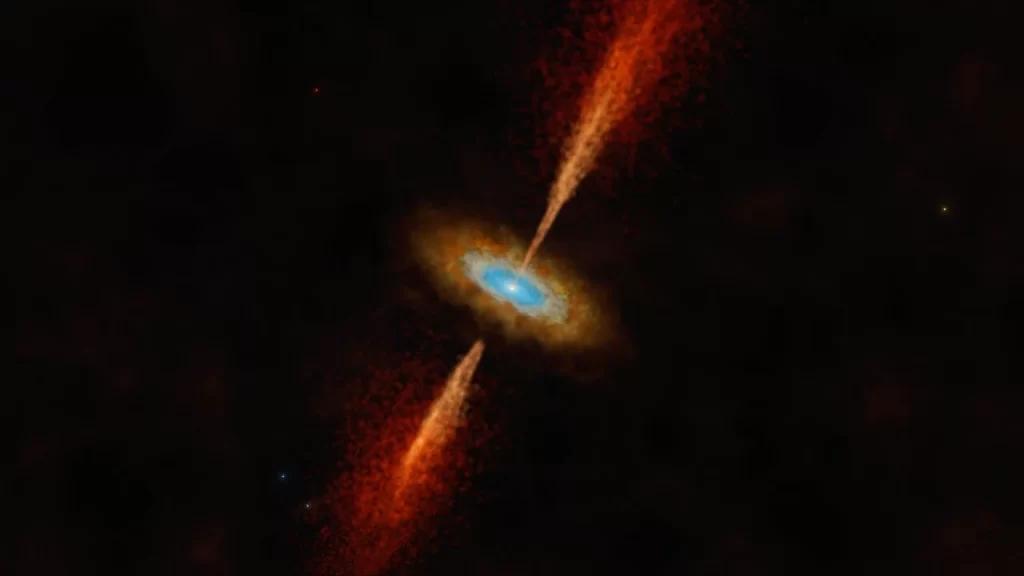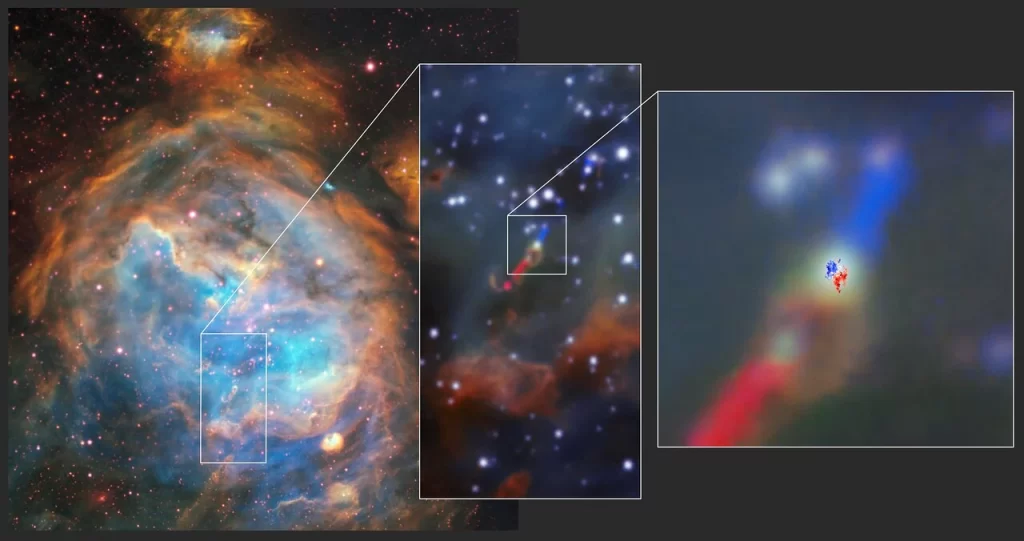Astronomers have made a noteworthy revelation by observing a disc encircling a juvenile star within the Large Magellanic Cloud, an adjacent galaxy to ours. It is the first time a disc of this type has been discovered beyond our galaxy, identical to the ones that form planets in our Milky Way. New observations unveil a juvenile, massive star that expands, absorbs matter from its environment, and forming a rotating disc. The Atacama Large Millimeter/submillimeter Array (ALMA) in Chile was used for the detection, in collaboration with The European Southern Observatory (ESO).
Anna McLeod, an associate professor at Durham University in the United Kingdom and primary author of the study published in Nature, stated that she could not believe the team had discovered the first extragalactic accretion disc when she first observed evidence of a rotating structure in the ALMA data. She further stated that while it is well understood that discs are essential for forming stars and planets in our galaxy, this is the first time that direct evidence of this has been observed in another galaxy.

Following observations with the Multi Unit Spectroscopic Explorer (MUSE) instrument on ESO’s Very Large Telescope (VLT), which detected a jet emanating from a young star (referred to as HH 1177) situated deep within a gaseous haze in the Large Magellanic Cloud, this research investigates the jet. McLeod says the team discovered a jet emanating from this juvenile massive star, indicating ongoing disc accretion. However, to verify the existence of said disc, the team had to conduct measurements on the motion of the dense atmosphere encircling the star.
Due to the gravitational attraction towards a growing star, matter cannot descend directly onto it. Instead, it transforms, transforming into a revolving disc encircling the star. As one approaches the centre, the disc accelerates in rotation; this speed differential serves as the smoking gun that notifies astronomers of the presence of an accretion disc.
According to Jonathan Henshaw, a study co-author and a research fellow at Liverpool John Moores University in the United Kingdom, the rate at which the gas emitting the light approaches or recedes from us determines whether the frequency of light changes. She continues, this is the same phenomenon that occurs when the frequency of an ambulance siren decreases as it passes you and its intensity increases.
By distinguishing the distinctive rotation of a disc using the precise frequency measurements obtained from ALMA, the authors could validate the detection of the initial disc encircling an extragalactic young star.

Massive stars undergo significantly faster formation and have considerably shorter lifetimes than low-mass stars like the Sun. Massive stars in our galaxy are notoriously difficult to observe, as they are frequently obscured by the nebulous material that forms around them as a disc forms. In contrast, the material from which new stars are formed in the Large Magellanic Cloud, a galaxy located 160,000 light-years away, is inherently distinct from that of the Milky Way. As a result of the reduced dust content, HH 1177 is no longer enveloped in its natal cocoon, providing astronomers with a distant yet unobstructed observation of the formation of stars and planets.
Technological advancements in astronomical facilities are accelerating, according to McLeod. She further states that it is extremely exciting to investigate the formation of stars at such vast distances and in a distinct galaxy.
International astronomy facility Atacama Large Millimeter/submillimeter Array (ALMA) is a collaboration between the Republic of Chile, the European Southern Observatory (ESO), the National Institutes of Natural Sciences (NINS) of Japan and the U.S. National Science Foundation (NSF). ALMA receives financial support from ESO on behalf of its Member States, NSF in collaboration with the National Science and Technology Council (NSTC) of Taiwan and the National Research Council of Canada (NRC), and NINS in partnership with the Korea Astronomy and Space Science Institute (KASI) and Academia Sinica (AS) in Taiwan. ESO oversees ALMA construction and operations on behalf of its Member States; Associated Universities, Inc. (AUI) manages the National Radio Astronomy Observatory (NRAO) on behalf of North America; and the National Astronomical Observatory of Japan (NAOJ) on behalf of East Asia. The unified leadership and administration of the construction, commissioning, and operation of ALMA is provided by the Joint ALMA Observatory (JAO).
The ESO empowers scientists around the globe to uncover the mysteries of the universe, fostering international collaboration for astronomy. ESO designs, constructs, and operates terrestrial observatories which astronomers employ to investigate and disseminate findings. ESO, which was founded in 1962 as an intergovernmental organisation, presently enjoys the backing of sixteen Member States. Australia serves as a Strategic Partner and the host nation of Chile. The sixteen Member States include Austria, Belgium, Denmark, France, Finland, the Czech Republic, Ireland, Germany, the Netherlands, Italy, Poland, Portugal, Spain, Switzerland, Sweden, and the United Kingdom. ESO’s visitor centre and planetarium, the ESO Supernova, are situated near Munich in Germany, whereas its observatories are situated in the Atacama Desert of Chile, a region with exceptional conditions for observing the sky. Three observation sites are managed by ESO: La Silla, Paranal, and Chajnantor. ESO administers the Very Large Telescope, the Very Large Telescope Interferometer, and survey telescopes, including VISTA from Paranal.
Additionally, Paranal ESO will host and operate the world’s largest and most sensitive gamma-ray observatory, the Cherenkov Telescope Array South. ALMA on Chajnantor, a facility ESO uses in collaboration with international partners, is designed to observe the sky in the submillimeter and millimetre scales. ESO is constructing its extremely large telescope, “the world’s largest eye on the heavens,” at Cerro Armazones, close to Paranal. ESO supports its operations in the country and interacts with Chilean partners and society from its offices in Santiago, Chile.

